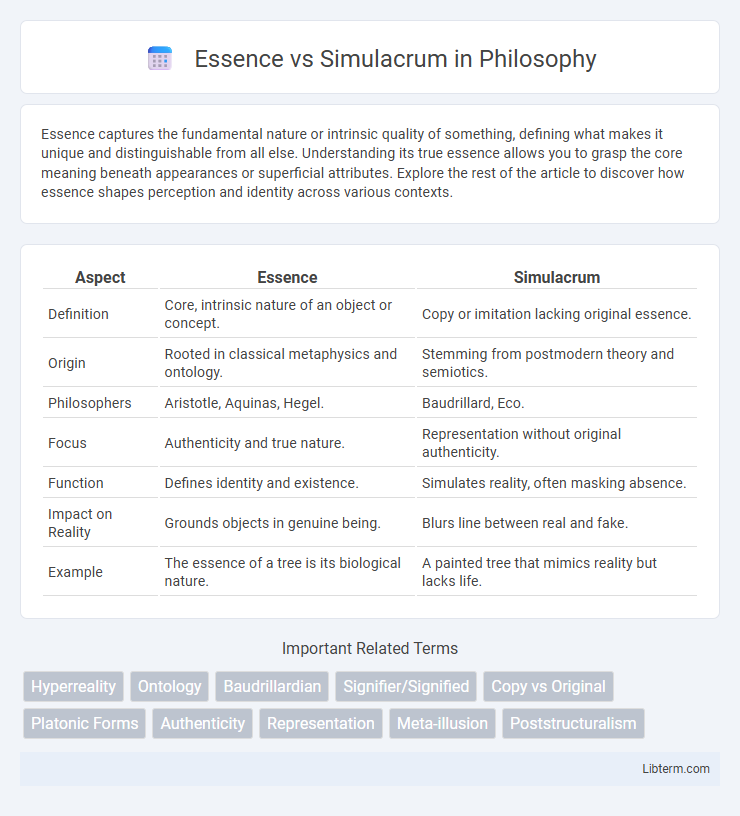Essence captures the fundamental nature or intrinsic quality of something, defining what makes it unique and distinguishable from all else. Understanding its true essence allows you to grasp the core meaning beneath appearances or superficial attributes. Explore the rest of the article to discover how essence shapes perception and identity across various contexts.
Table of Comparison
| Aspect | Essence | Simulacrum |
|---|---|---|
| Definition | Core, intrinsic nature of an object or concept. | Copy or imitation lacking original essence. |
| Origin | Rooted in classical metaphysics and ontology. | Stemming from postmodern theory and semiotics. |
| Philosophers | Aristotle, Aquinas, Hegel. | Baudrillard, Eco. |
| Focus | Authenticity and true nature. | Representation without original authenticity. |
| Function | Defines identity and existence. | Simulates reality, often masking absence. |
| Impact on Reality | Grounds objects in genuine being. | Blurs line between real and fake. |
| Example | The essence of a tree is its biological nature. | A painted tree that mimics reality but lacks life. |
Understanding the Concepts: Essence and Simulacrum
Essence refers to the intrinsic, unchanging nature or fundamental quality that defines an entity or concept, representing its true reality beyond appearances. Simulacrum, on the other hand, denotes a copy or representation that replaces or distorts the original essence, leading to a hyperreal condition where distinctions between reality and imitation blur. Grasping the difference between essence and simulacrum is crucial for analyzing how meaning and authenticity are constructed and perceived in culture and philosophy.
Historical Origins of Essence and Simulacrum
The concept of essence originates from ancient Greek philosophy, particularly Aristotle, who defined essence as the intrinsic nature or indispensable quality of a thing that determines its identity. Simulacrum, on the other hand, emerged from Plato's theory of forms, where simulacra are mere copies or imitations of reality without the original substance. Over time, simulacrum evolved within postmodern philosophy, especially through Jean Baudrillard, who argued that simulacra replace reality, creating hyperreal representations detached from any true essence.
Philosophical Perspectives on Essence
Philosophical perspectives on essence explore the intrinsic nature or fundamental properties that define an entity's identity, distinguishing it from mere appearances or representations. Essence is often contrasted with simulacrum, which refers to a copy or imitation lacking the original's authentic characteristics, resulting in a loss of meaning or truth. Thinkers such as Aristotle emphasize essence as a core reality, while postmodern philosophers like Baudrillard critique the collapse of essence into endless simulacra, challenging traditional notions of authenticity.
Simulation and the Birth of the Simulacrum
Simulation transforms reality into a series of signs that no longer reference an original essence, leading to the birth of the simulacrum as a copy without an authentic source. The simulacrum represents a hyperreality where distinctions between reality and representation dissolve, challenging traditional notions of truth and authenticity. This process undermines the essence by creating a world dominated by simulations that replace and replicate reality itself.
Essence vs Simulacrum: Key Differences
Essence represents the intrinsic nature or fundamental truth of an object, while Simulacrum is a superficial or imitative representation lacking the original's depth. Essence is tied to authenticity and core identity, whereas Simulacrum involves copies or replicas that may distort or replace reality. Understanding these key differences highlights the contrast between genuine existence and mere imitation in philosophy and semiotics.
The Role of Representation in Shaping Reality
Representation serves as the bridge between essence and simulacrum, where essence embodies the intrinsic truth of an object or concept, while simulacrum reproduces its image without authenticity. This distinction shapes reality by influencing perception; society often interacts with the simulacrum, mistaking it for the genuine essence, thus constructing a mediated reality. The power of representation lies in its ability to redefine what is accepted as real, blurring the boundary between original meaning and artificial imitation.
Cultural and Media Influences on Simulacra
Cultural and media influences significantly shape the formation of simulacra by reproducing images and narratives detached from their original context, leading to hyperreal experiences where representations become more influential than reality itself. Media platforms amplify simulacra through constant circulation of signs and symbols that reshape public perception and dismantle the boundary between essence and imitation. This process creates a culture dominated by surface-level meanings, reinforcing Baudrillard's theory of the simulacrum as a copy without an original.
Essence in Modern Identity and Authenticity
Essence in modern identity emphasizes the intrinsic qualities and core values that define an individual's true self, resisting the superficial layers imposed by external perceptions. Authenticity arises from embracing these unchanging characteristics, fostering genuine connections and self-expression in a world dominated by simulacra and constructed images. This ontological foundation anchors personal identity amidst societal pressures for conformity and representation.
Simulacra and Hyperreality in Contemporary Society
Simulacra in contemporary society represent copies or representations that have lost their connection to the original essence, creating a reality based on images and symbols rather than authentic experience. Hyperreality blurs the line between reality and simulation, where media, advertising, and digital technologies fabricate perceptions that feel more real than actual reality. This phenomenon influences social interactions, consumer behavior, and cultural norms, embedding a constructed experience that replaces genuine existence.
Future Implications: Navigating Essence and Simulacrum
Navigating the future implications of Essence versus Simulacrum requires understanding how authentic meaning shapes human identity in a digital age dominated by replicas and simulations. Advances in artificial intelligence and virtual realities challenge the distinction between original essence and constructed simulacra, impacting societal values and decision-making processes. Emphasizing ethical frameworks and critical media literacy is essential to preserve genuine experiences while engaging with increasingly simulated environments.
Essence Infographic

 libterm.com
libterm.com